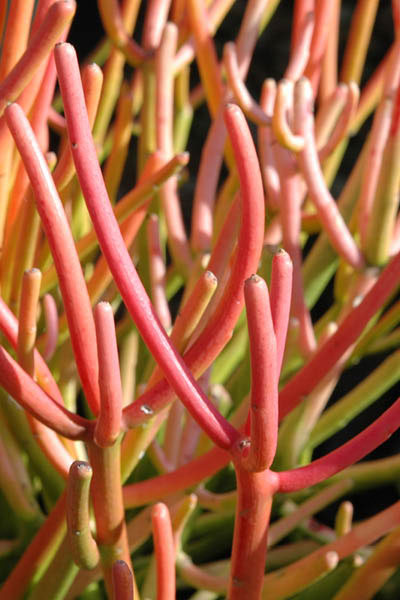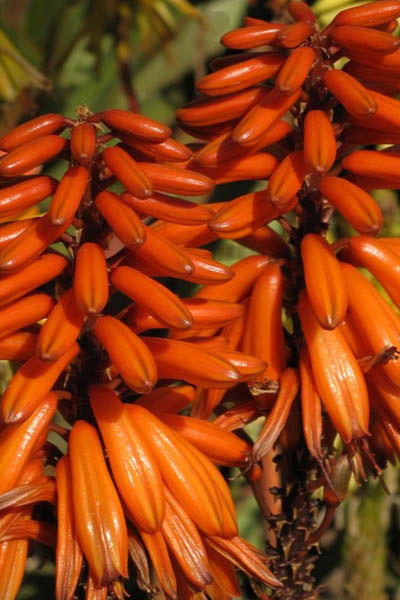These trendy indigenous plants will add local flavour to your garden whether you have a meadow, water-wise plantings or a formal garden
EUPHORBIA TIRUCALLI ‘FIRESTICKS’
Firesticks
This red form of the indigenous euphorbia with its many branched cylindrical, finger-like stems looks like an eye-catching cluster of coral. A succulent shrub with few leaves, its colour is best in winter and spring, although it’s still impressive in summer when it fades to yellow. Size: 3–5m x 2m.
MAKE THE MOST OF IT: Use this striking plant to liven up other water-wise plants, between aloes for all-year colour, or place it in front of a piece of driftwood or a craggy rock. It looks dramatic in a pot and makes a good hedging plant in dry regions.
GROWING TIPS: ‘Firesticks’ shows its true colours when grown in full sun. It’s drought tolerant and dislikes wet feet in winter. It prefers warm regions but tolerates mild frost and grows well when given fertiliser.
Caution: Like all euphorbias, its milky latex, which flows freely when the plant is damaged, can burn the skin.
YOU’LL ALSO LOVE: An easy way to propagate succulents
KALENCHOE THYRSIFLORA (PADDLE OR FLAPJACK PLANT)
“Selecting plants for the garden isn’t only about flowers but also about the size and texture of the leaves,” says indigenous plant enthusiast, Linda de Luca of Random Harvest Nursery. She adds that this succulent with its dramatic concertina-like, saucer-sized leaves also provides colour as its leaves are often tinged with red. Height: 30cm; flower stalks: 1,25m.
MAKE THE MOST OF IT: Don’t relegate this succulent to the rockery; show it off by grouping a few in front of a large rock or driftwood. It looks stunning in terracotta pots, works well in gravel gardens (combine it with other succulents), but can also be used to bring colour and interest to beds, borders and verges.
GROWING TIPS: When grown in full sun, its red colouring is at its most intense; in semi-shade, the leaves will be pale jade green with a red rim. Although water wise, it tolerates regular watering. Don’t worry when the plants die back after flowering (after 2–4 years) as new plantlets will develop at the base. Plantlets also develop along the flower stalk.
READ MORE: 3 Container ideas for succulents
ALOE-‘TIGER-EYE’
Aloes, whether they’re the species found in the veld or the modern cultivars and hybrids, all have great architectural form and striking flowers, usually in winter. “Aloe ‘Tiger Eye’, is a winner as it’s a re-blooming aloe, flowering on and off all year. It peaks in late winter and has a really stunning shiny colour,” says award-winning landscaper, Leon Kluge of Leon Kluge Garden Design. Size: Height 60–70cm; width 40–50cm.
READ MORE: Easy to grow aloes
MAKE THE MOST OF IT: Mass planting this knee-high aloe makes a real impact in larger landscapes but a single plant can also be used as a focal point. Bred by De Wet Plant Breeders, it looks good when combined with grasses and it adds colour to the flower border.
GROWING TIPS: Plant it in full sun or a slightly shaded place. Although drought tolerant, it can be grown in areas under irrigation but must have good drainage (sand and loam are better than clay) and not be overwatered. Feed with 3:1:5 or 5:1:5 fertiliser. Although it has a high cold tolerance, the flowers can suffer frost damage.
